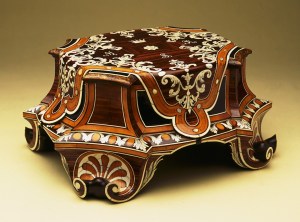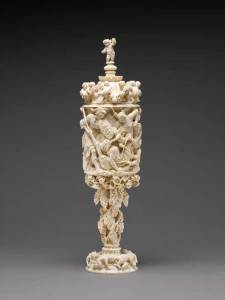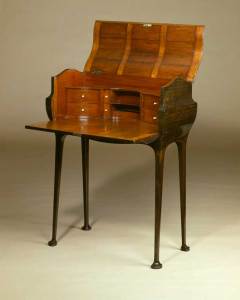In Apollo’s June issue, Martin Levy discusses the impact of the proposed US ivory ban on historical scholarship and the cultural sector.
What do these three objects have in common? A cup by Balthasar Griessmann dating from c. 1680 (J. Paul Getty Museum, Los Angeles), a stand by Pietro Piffetti dating from c. 1740 (Los Angeles County Museum of Art) and the 1891 ‘Lady’s writing desk’ designed by Mervyn Macartney for Kenton & Co. (Minneapolis Institute of Arts). The answer is ivory. The cup is made of ivory, the stand incorporates ivory and the desk has ivory drawer knobs. Amendments in 1997 to the original 1973 Convention on the International Trade in Endangered Species of Wild Fauna and Flora (CITES) continued to allow their import from Europe.

Stand (c. 1740), Pietro Piffetti . Image: LACMA
On 11 February 2014, the Obama Administration released details of a ‘National Strategy for Combating Wildlife Trafficking & Commercial Ban on Trade in Elephant Ivory’. This document shocked curators, scholars, connoisseurs and collectors by making no proper distinction between old works of art and illegally poached and trafficked tusks. Under the terms of the proposed legislation, now being scrutinised on Capitol Hill (and independently mooted by some States, such as New York), none of the museum acquisitions cited above would now be possible. Why? Because there is to be a ban on the commercial import of African ivory, including hitherto exempt antique works of art. Indeed, there is evidence that a de facto ban is already in place.
The 1997 regulations allowed signatory jurisdictions to adopt their own rules relating to the trade in ‘worked’ ivory. Europe adopted a 50-year rule, thereby permitting trade in ivory worked before 1947 (the cut off date in the States is, somewhat puzzlingly, 100 years). Although evidence is required to establish the history of ownership before 1947, in the UK the Department for Environment, Food and Rural Affairs (Defra) effectively recognises the extent to which such proof seldom survives and pragmatically judges each application for a CITES permit on its merit, taking into account all the information submitted about the artefacts, their age and history. Defra maintains the reasonable distinction between the reprehensible trade in illicit ivory, and the quite different nature of authenticated pre-1947 works of art made from or containing ivory.

Ivory goblet (c. 1680), Balthasar Griessmann. Photo: Getty Museum
The preservation of endangered species rightly enjoys universal support. The existence of CITES has done much to ensure that we will not see the elephant and the rhinoceros go the way of the dodo. Worldwide conservation organisations admirably and vociferously keep up the pressure to protect our fauna and flora from extinction at all costs. Hillary and Chelsea Clinton, for example, are on record endorsing ‘a complete ban on ivory sales in the US’. But surely including pre-1947 cultural artefacts, which have the power to inform and educate about different cultures and times, is an example of the ‘law of unintended consequences’.
The Fish and Wildlife Service (F&WS), which is responsible for the implementation of CITES in the US, has expressed concern that much illicit ivory arrives in the country under the guise of being old. This is hard to understand. If in the world of art history differences over attribution and authenticity are part of day-to-day discourse, it can also be said with confidence that controversies over the dating of ivory sculpture and other works of art (whether the raw material was of African or Indian origin) do not exist: this is not an issue.

‘Lady’s writing desk’ designed by Mervyn Macartney for Kenton & Co. Minneapolis Institute of Arts
According to Getty Trust president James Cuno, the proposed ban on ivory would ‘inhibit our appreciation…of these antique objects and their cultural role.’ Last year, Minneapolis curator Eike Schmidt organised ‘Diaphanous Passions: Baroque Ivories from the Courts of Europe’ at the Museo degli Argenti, Florence, affording specialists the unique opportunity to compare exhibits, drawn from important collections, under the same roof. The show received over 300,000 visitors. More recently, and acknowledging the benefit of time spent at the Metropolitan, where she could ‘discuss the ivories in the New York collection with a great number of helpful and knowledgeable colleagues’, Marjorie Trusted has published a major catalogue of some of the works in ivory belonging to the V&A. It is clear that American collections and international exchanges benefit scholarship, and more generally education, while also encouraging appreciation from a wider public of mankind’s artistic heritage.
It has become clear that US officials, and some in Congress, had perhaps not appreciated that widely welcomed legislation to protect the African elephant had failed to recognise the cultural value of works of art that happen to be made of ivory. Although this issue needs to be solved in the States, the implications are international. There is no reason that common sense should not prevail, but it will take diplomatic skills on both sides to find a workable and mutually satisfactory solution.
Click here to subscribe to Apollo
Join the debate and tell us what you think. Leave a comment below…
Related Articles
Forum: Does today’s art market benefit young artists (April Apollo)
Forum: Is it ever justifiable to burn a fake? (March Apollo)
Forum: Have traditional museum and exhibition catalogues had their day? (February Apollo)
Forum: Deaccession Debates (September Apollo)

Forum: Is the US ivory ban counter-productive?
Stand (c. 1740), Pietro Piffetti . Image: LACMA
Share
In Apollo’s June issue, Martin Levy discusses the impact of the proposed US ivory ban on historical scholarship and the cultural sector.
What do these three objects have in common? A cup by Balthasar Griessmann dating from c. 1680 (J. Paul Getty Museum, Los Angeles), a stand by Pietro Piffetti dating from c. 1740 (Los Angeles County Museum of Art) and the 1891 ‘Lady’s writing desk’ designed by Mervyn Macartney for Kenton & Co. (Minneapolis Institute of Arts). The answer is ivory. The cup is made of ivory, the stand incorporates ivory and the desk has ivory drawer knobs. Amendments in 1997 to the original 1973 Convention on the International Trade in Endangered Species of Wild Fauna and Flora (CITES) continued to allow their import from Europe.
Stand (c. 1740), Pietro Piffetti . Image: LACMA
On 11 February 2014, the Obama Administration released details of a ‘National Strategy for Combating Wildlife Trafficking & Commercial Ban on Trade in Elephant Ivory’. This document shocked curators, scholars, connoisseurs and collectors by making no proper distinction between old works of art and illegally poached and trafficked tusks. Under the terms of the proposed legislation, now being scrutinised on Capitol Hill (and independently mooted by some States, such as New York), none of the museum acquisitions cited above would now be possible. Why? Because there is to be a ban on the commercial import of African ivory, including hitherto exempt antique works of art. Indeed, there is evidence that a de facto ban is already in place.
The 1997 regulations allowed signatory jurisdictions to adopt their own rules relating to the trade in ‘worked’ ivory. Europe adopted a 50-year rule, thereby permitting trade in ivory worked before 1947 (the cut off date in the States is, somewhat puzzlingly, 100 years). Although evidence is required to establish the history of ownership before 1947, in the UK the Department for Environment, Food and Rural Affairs (Defra) effectively recognises the extent to which such proof seldom survives and pragmatically judges each application for a CITES permit on its merit, taking into account all the information submitted about the artefacts, their age and history. Defra maintains the reasonable distinction between the reprehensible trade in illicit ivory, and the quite different nature of authenticated pre-1947 works of art made from or containing ivory.
Ivory goblet (c. 1680), Balthasar Griessmann. Photo: Getty Museum
The preservation of endangered species rightly enjoys universal support. The existence of CITES has done much to ensure that we will not see the elephant and the rhinoceros go the way of the dodo. Worldwide conservation organisations admirably and vociferously keep up the pressure to protect our fauna and flora from extinction at all costs. Hillary and Chelsea Clinton, for example, are on record endorsing ‘a complete ban on ivory sales in the US’. But surely including pre-1947 cultural artefacts, which have the power to inform and educate about different cultures and times, is an example of the ‘law of unintended consequences’.
The Fish and Wildlife Service (F&WS), which is responsible for the implementation of CITES in the US, has expressed concern that much illicit ivory arrives in the country under the guise of being old. This is hard to understand. If in the world of art history differences over attribution and authenticity are part of day-to-day discourse, it can also be said with confidence that controversies over the dating of ivory sculpture and other works of art (whether the raw material was of African or Indian origin) do not exist: this is not an issue.
‘Lady’s writing desk’ designed by Mervyn Macartney for Kenton & Co. Minneapolis Institute of Arts
According to Getty Trust president James Cuno, the proposed ban on ivory would ‘inhibit our appreciation…of these antique objects and their cultural role.’ Last year, Minneapolis curator Eike Schmidt organised ‘Diaphanous Passions: Baroque Ivories from the Courts of Europe’ at the Museo degli Argenti, Florence, affording specialists the unique opportunity to compare exhibits, drawn from important collections, under the same roof. The show received over 300,000 visitors. More recently, and acknowledging the benefit of time spent at the Metropolitan, where she could ‘discuss the ivories in the New York collection with a great number of helpful and knowledgeable colleagues’, Marjorie Trusted has published a major catalogue of some of the works in ivory belonging to the V&A. It is clear that American collections and international exchanges benefit scholarship, and more generally education, while also encouraging appreciation from a wider public of mankind’s artistic heritage.
It has become clear that US officials, and some in Congress, had perhaps not appreciated that widely welcomed legislation to protect the African elephant had failed to recognise the cultural value of works of art that happen to be made of ivory. Although this issue needs to be solved in the States, the implications are international. There is no reason that common sense should not prevail, but it will take diplomatic skills on both sides to find a workable and mutually satisfactory solution.
Click here to subscribe to Apollo
Join the debate and tell us what you think. Leave a comment below…
Related Articles
Forum: Does today’s art market benefit young artists (April Apollo)
Forum: Is it ever justifiable to burn a fake? (March Apollo)
Forum: Have traditional museum and exhibition catalogues had their day? (February Apollo)
Forum: Deaccession Debates (September Apollo)
Unlimited access from just $16 every 3 months
Subscribe to get unlimited and exclusive access to the top art stories, interviews and exhibition reviews.
Share
Recommended for you
Postage paid: Sotheby’s stamp estimated at $10–20million
The British Guiana One-Cent Magenta is the only stamp of its kind in the world, and by far the most expensive
First Look: ‘British And German Art After 1945’ at the Sprengel Museum Hannover
A curator’s introduction to the Sprengel Museum’s upcoming exhibition
Review: Tate’s ‘Matisse Live’
It was an interesting broadcast, but Tate’s tour around its Matisse show gained little from being ‘live’